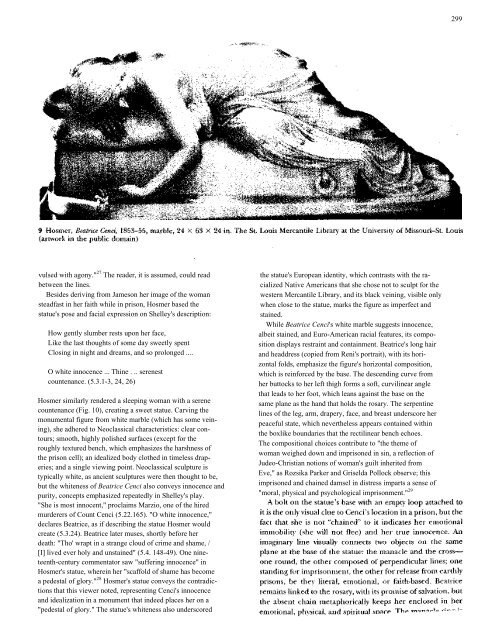of Incest and Female Relations in Harriet Hosmer's Beatrice Cenci
of Incest and Female Relations in Harriet Hosmer's Beatrice Cenci
of Incest and Female Relations in Harriet Hosmer's Beatrice Cenci
Create successful ePaper yourself
Turn your PDF publications into a flip-book with our unique Google optimized e-Paper software.
vulsed with agony." 27 The reader, it is assumed, could read<br />
between the l<strong>in</strong>es.<br />
Besides deriv<strong>in</strong>g from Jameson her image <strong>of</strong> the woman<br />
steadfast <strong>in</strong> her faith while <strong>in</strong> prison, Hosmer based the<br />
statue's pose <strong>and</strong> facial expression on Shelley's description:<br />
How gently slumber rests upon her face,<br />
Like the last thoughts <strong>of</strong> some day sweetly spent<br />
Clos<strong>in</strong>g <strong>in</strong> night <strong>and</strong> dreams, <strong>and</strong> so prolonged ....<br />
O white <strong>in</strong>nocence ... Th<strong>in</strong>e . .. serenest<br />
countenance. (5.3.1-3, 24, 26)<br />
Hosmer similarly rendered a sleep<strong>in</strong>g woman with a serene<br />
countenance (Fig. 10), creat<strong>in</strong>g a sweet statue. Carv<strong>in</strong>g the<br />
monumental figure from white marble (which has some ve<strong>in</strong>-<br />
<strong>in</strong>g), she adhered to Neoclassical characteristics: clear con-<br />
tours; smooth, highly polished surfaces (except for the<br />
roughly textured bench, which emphasizes the harshness <strong>of</strong><br />
the prison cell); an idealized body clothed <strong>in</strong> timeless drap-<br />
eries; <strong>and</strong> a s<strong>in</strong>gle view<strong>in</strong>g po<strong>in</strong>t. Neoclassical sculpture is<br />
typically white, as ancient sculptures were then thought to be,<br />
but the whiteness <strong>of</strong> <strong>Beatrice</strong> <strong>Cenci</strong> also conveys <strong>in</strong>nocence <strong>and</strong><br />
purity, concepts emphasized repeatedly <strong>in</strong> Shelley's play.<br />
"She is most <strong>in</strong>nocent," proclaims Marzio, one <strong>of</strong> the hired<br />
murderers <strong>of</strong> Count <strong>Cenci</strong> (5.22.165). "O white <strong>in</strong>nocence,"<br />
declares <strong>Beatrice</strong>, as if describ<strong>in</strong>g the statue Hosmer would<br />
create (5.3.24). <strong>Beatrice</strong> later muses, shortly before her<br />
death: "Tho' wrapt <strong>in</strong> a strange cloud <strong>of</strong> crime <strong>and</strong> shame, /<br />
[I] lived ever holy <strong>and</strong> unsta<strong>in</strong>ed" (5.4. 148-49). One n<strong>in</strong>e-<br />
teenth-century commentator saw "suffer<strong>in</strong>g <strong>in</strong>nocence" <strong>in</strong><br />
<strong>Hosmer's</strong> statue, where<strong>in</strong> her "scaffold <strong>of</strong> shame has become<br />
a pedestal <strong>of</strong> glory." 28 <strong>Hosmer's</strong> statue conveys the contradic-<br />
tions that this viewer noted, represent<strong>in</strong>g <strong>Cenci</strong>'s <strong>in</strong>nocence<br />
<strong>and</strong> idealization <strong>in</strong> a monument that <strong>in</strong>deed places her on a<br />
"pedestal <strong>of</strong> glory." The statue's whiteness also underscored<br />
the statue's European identity, which contrasts with the ra-<br />
cialized Native Americans that she chose not to sculpt for the<br />
western Mercantile Library, <strong>and</strong> its black ve<strong>in</strong><strong>in</strong>g, visible only<br />
when close to the statue, marks the figure as imperfect <strong>and</strong><br />
sta<strong>in</strong>ed.<br />
While <strong>Beatrice</strong> <strong>Cenci</strong>'s white marble suggests <strong>in</strong>nocence,<br />
albeit sta<strong>in</strong>ed, <strong>and</strong> Euro-American racial features, its compo-<br />
sition displays restra<strong>in</strong>t <strong>and</strong> conta<strong>in</strong>ment. <strong>Beatrice</strong>'s long hair<br />
<strong>and</strong> headdress (copied from Reni's portrait), with its hori-<br />
zontal folds, emphasize the figure's horizontal composition,<br />
which is re<strong>in</strong>forced by the base. The descend<strong>in</strong>g curve from<br />
her buttocks to her left thigh forms a s<strong>of</strong>t, curvil<strong>in</strong>ear angle<br />
that leads to her foot, which leans aga<strong>in</strong>st the base on the<br />
same plane as the h<strong>and</strong> that holds the rosary. The serpent<strong>in</strong>e<br />
l<strong>in</strong>es <strong>of</strong> the leg, arm, drapery, face, <strong>and</strong> breast underscore her<br />
peaceful state, which nevertheless appears conta<strong>in</strong>ed with<strong>in</strong><br />
the boxlike boundaries that the rectil<strong>in</strong>ear bench echoes.<br />
The compositional choices contribute to "the theme <strong>of</strong><br />
woman weighed down <strong>and</strong> imprisoned <strong>in</strong> s<strong>in</strong>, a reflection <strong>of</strong><br />
Judeo-Christian notions <strong>of</strong> woman's guilt <strong>in</strong>herited from<br />
Eve," as Rozsika Parker <strong>and</strong> Griselda Pollock observe; this<br />
imprisoned <strong>and</strong> cha<strong>in</strong>ed damsel <strong>in</strong> distress imparts a sense <strong>of</strong><br />
"moral, physical <strong>and</strong> psychological imprisonment." 29<br />
299
















